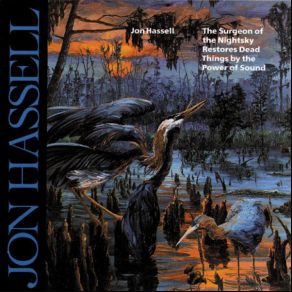The Surgeon of the Nightsky Restores Dead Things by the Power of Sound
Download links and information about The Surgeon of the Nightsky Restores Dead Things by the Power of Sound by Jon Hassell. This album was released in 1987 and it belongs to New Age, Electronica, Jazz, Rock genres. It contains 5 tracks with total duration of 53:31 minutes.

|
|
|---|---|
| Artist: | Jon Hassell |
| Release date: | 1987 |
| Genre: | New Age, Electronica, Jazz, Rock |
| Tracks: | 5 |
| Duration: | 53:31 |
| Buy it NOW at: | |
| Buy on iTunes $10.99 | |
| Buy on Amazon $4.95 | |
Tracks
[Edit]| No. | Title | Length |
|---|---|---|
| 1. | Ravinia / Vancouver | 20:57 |
| 2. | Paris I | 5:48 |
| 3. | Hamburg | 7:10 |
| 4. | Brussels | 10:56 |
| 5. | Paris II | 8:40 |
Details
[Edit]"Raga" trumpeter Jon Hassell's The Surgeon of the Nightsky Restores Dead Things by the Power of Sound utilizes the core ensemble of players previously heard on Power Spot, but with quite different results. Surgeon of the Nightsky is considerably more ambient and less rhythmically animated than its predecessor. Each of the five tracks is named after a city, a theme Hassell would further explore in the subsequent City: Works of Fiction. The tracks of Surgeon of the Nightsky melt seamlessly into one another, forming an unbroken arc that spans the entire album. The opening "Ravinia/Vancouver" is a two-part form. "Ravinia" opens with a grooving bassline and hovering, synthesized strings. From his harmonized trumpet, Hassell conjures shapely melodies that gradually return transformed as loops, creating a polyrhythmic grid that elicits his further melodic commentary. "Ravinia" dissolves almost imperceptibly into "Vancouver," which is based on a recurring, 22-beat rhythmic cycle in the electronic percussion and a two-chord bass drone. With the strings still floating in the background, Hassell's harmonized trumpet reshapes melodic fragments from "Ravinia." Serenity prevails as "Vancouver gently trails away. For Hassell, a unique European ambience flavors the relatively brief "Paris I." Detached percussion patterns never fully coalesce, cloudy synthesizer tones drift past as the bassline from "Ravinia" emerges and then disappears. Throughout, a collage of synthesizers veils Hassell's intermittent trumpeting. Hassell's horn resounds in "Hamburg"; trumpet choirs and pulsing bass and percussion lure his echo-laden melodies out of hiding. "Brussels" revisits themes from "Charm (Over 'Burundi Cloud')," one of Hassell's most compelling recordings. "Brussels" hints at the sparse, haunting beauty of "Charm," but is burdened by the overabundant synthesizers. "Paris II" opens with Hassell's remarkably flute-like sound swirling in long delay lines. Quotes from his "Chor Moiré" ripple across the luminous pastel surfaces. Hassell's patient, breathy vocalisms bring the album to a quiet closing. Steeped in an ethereal cool, Surgeon of the Nightsky reflects Hassell's unique brand of minimalism. Rarely does the ensemble reach the intensity level of "Charm" or Power Spot; perhaps that is the point. The minimal textures and timbres are generally lucid and effective, but have a static sameness that can enthrall or unnerve. One wonders if a more compelling ensemble interaction — perhaps with an acoustic string section and indigenous percussion — could have lifted this material to even greater heights.